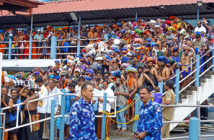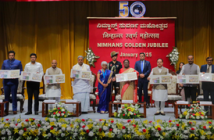Prime Minister Shri Narendra Modi today launched the Gati Shakti – National Master Plan for Multi-modal connectivity in New Delhi, heralding a new chapter in governance. Gati Shakti — a digital platform — will bring 16 Ministries including Railways and Roadways together for integrated planning and coordinated implementation of infrastructure connectivity projects.
It will incorporate the infrastructure schemes of various Ministries and State Governments like Bharatmala, Sagarmala, inland waterways, dry/land ports, UDAN etc. Economic Zones like textile clusters, pharmaceutical clusters, defence corridors, electronic parks, industrial corridors, fishing clusters, agri zones will be covered to improve connectivity & make Indian businesses more competitive. It will also leverage technology extensively including spatial planning tools with ISRO imagery developed by BiSAG-N (Bhaskaracharya National Institute for Space Applications and Geoinformatics). More details of the Plan can be found here.
The multi-modal connectivity will provide integrated and seamless connectivity for movement of people, goods and services from one mode of transport to another. It will facilitate the last mile connectivity of infrastructure and also reduce travel time for people.

Mumbai Port Trust projects promoting multi-modal connectivity
In line with the goals of PM Gati Shakti, Mumbai Port Trust is undertaking a slew of projects promoting multimodal connectivity. “The Trust has set the goal of seeking harmony between the needs of the cargoes and ships on one hand and the needs of the city (Mumbai) and citizenry on the other” said CMD Shri Rajeev Jalota.
The multimodal connectivity master plan of Mumbai Port Trust is founded on two pillars, namely cargo-related projects and Sea Tourism.
I. Cargo-related Projects of Mumbai Port Trust
Expanding POL capacity: The biggest crude oil jetty with a capacity of 22 Million Tonnes Per Annum is constructed at Marine Oil Terminal with pipeline connectivity for its evacuation. This project released other four jetties for more coastal traffic of P.O.L ((Petroleum Oil and Lubricant).
Bunkering Terminal: This project takes advantage of the more than 5,000 ships visiting the Mumbai Harbour annually, utilizing Pipelines connectivity for its evacuation.
Facility for LNG handing: This project shall provide LNG as clean energy up to 5 Million Tonnes per annum without creating stress on land side facilities as the Floating Terminal would be in sea and evacuation of LNG would be through pipelines connectivity with the National Grid.
Barging of containers between JNPT and Mumbai: This project is to get more containers from JNPT through waterways connectivity, by covering only a distance of 14 kms, thereby eliminating a long road journey of 120 kms and its resultant pollution and road congestion.
Coastal facilities:
Berth No. 10, 11 of Indira Dock along with a shed, are exclusively reserved for handling of coastal cargo.
Erection of temporary silos for bulk commodities of Cement Fly Ash on MbPT land by private parties. EOI has been already invited.
Improving Rail Connectivity
Most importantly, to improve Rail connectivity to the dedicated rail freight corridor to Delhi, Mumbai port is reworking on its rail assets on two fronts. On one hand it has planned to reorganize and upgrade the railway network and operations by handing over the rail assets to a dedicated govt. company – Indian Port Railway & Ropeway company Ltd. On the other hand, a dedicated rail line for port freight movement from Wadala to Kurla is being laid. This will relieve the suburban rail on Harbour line benefitting the commuters.
II. Sea Tourism Projects of Mumbai Port Trust
International Cruise Terminal (ICT): The most important and ambitious project for Cruise Tourism, not only for Mumbai but for India, is the Mumbai International Cruise Terminal, which is under development at Ballard Pier extension berth at an estimated cost of Rs. 500/- Crores. This terminal shall not only be used for Cruise ships, but also by the city folks as it will have retails, Restaurants, leisure areas and many more facilities.
1 km- long Mumbai Port Waterfront at Prince’s & Victoria Dock Wall: This integrated water transport hub will have all modern requirements for the leisure and commuting for city folks. This facility has a Ro-Pax Terminal and will include sea side Restaurants, Amphitheatre, Domestic Cruise Terminal, Marina, Floating Restaurants, Harbour Cruises, Water taxis, etc.
Ro-Pax Terminal: It is perfect example of harnessing water ways for commuting / tourist movements and reducing the road traffic. Ro-Pax services between Mumbai and Mandwa opens up a new commuter / tourist transportation connecting these two important nodes. This will be extended to connect to Navi Mumbai’s new upcoming airport. The Ropax ship is operating, bringing a huge relief for travelers combining Multimodal transportation of Roadways & Waterways.
Ropeway between Sewree to Elephanta: The World’s longest Rope way over the sea of approx. 8 Kms. shall be built in PPP mode costing about Rs.700/- Crores. This project will open up new travel mode for the City’s population besides giving beautiful view of marine facilities like ships, Marine Oil Terminal, and the upcoming Mumbai Trans Harbour Link etc.



